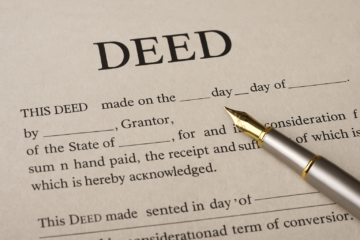Navigating the world of real property can be overwhelming, especially when it comes to understanding deed transfers. In this blog, we’ll break down the essentials of deed transfers, making it simple and easy to grasp.
Understanding Deeds: A Brief Overview
Deeds are legal documents representing the ownership of real property. They play a crucial role in transferring ownership from one party to another. Without the correct deed, a property transfer cannot be legally recognized.
The primary purpose of a deed is to provide clear evidence of property ownership. A deed must include essential elements such as the identity of the grantor and grantee, a legal description of the property, and operative words indicating the transfer of ownership. When dealing with real property, it’s necessary to ensure all these components are present to establish a valid transfer. Being well-informed about the legal criteria for deeds helps property buyers and sellers avoid potential pitfalls in ownership disputes.
Interestingly, deeds have been around for centuries, evolving to meet the complexities of modern real estate transactions. Whether you’re a first-time homebuyer or a seasoned investor, understanding the historical context and function of deeds can provide insight into their modern-day applications. For those looking to add or remove a party to a deed in the Maryland area, consulting a professional is crucial. It’s a significant decision with various factors to consider, as explained in the Guide to Deed Transfer Considerations.
Different Types of Deed Transfers
There are several types of deed transfers, including warranty deeds, quitclaim deeds, and special warranty deeds. Each type offers different levels of protection for the buyer and comes with unique implications.
The warranty deed is one of the most common types, offering the highest level of buyer protection. With this deed, the seller assures the buyer that they hold clear title to the property, and there are no undisclosed encumbrances. It provides a comprehensive guarantee against any title defects, both historical and current. On the other hand, a quitclaim deed offers minimal protection as it simply transfers any ownership interest the grantor has, without any warranties. This type of deed is often used for transfers between family members where trust is already established.
A special warranty deed strikes a balance between the previous two, offering limited assurances. In this scenario, the grantor only guarantees that there were no issues with the title during their ownership. When considering which deed to use, it’s important to have a thorough understanding of the property’s history and any existing claims against it. If you’re curious about whether a title search is necessary for your deed transfer, you can find valuable insights on that topic here.
The Role of Title Insurance
Title insurance is a key component in protecting property owners and lenders against any claims or legal issues arising from defects in the property’s title. It’s an essential part of the deed transfer process.
Obtaining title insurance is a safeguard against potential legal issues that may arise due to unforeseen title defects. These defects could include outstanding liens, fraudulent claims, or previous ownership disputes. By securing title insurance, property buyers protect themselves from financial losses related to these issues. It’s like purchasing peace of mind, knowing that if a past owner emerges with a claim, the insurance policy will cover the costs of legal defense or settlements.
Moreover, the benefits of title insurance extend to lenders, as their investments in property mortgages are protected. In the event of a title dispute, lenders can recover outstanding debts, ensuring they are not left with significant losses. For a smoother and more efficient title management process, title insurance is often paired with electronically recorded deeds, a modern convenience enhancing the real estate landscape by reducing errors and speeding up transactions.
Steps in the Deed Transfer Process
The deed transfer process typically involves preparation, execution, delivery, and recording. Each step is vital to ensuring the transfer is legally binding and fully recognized.
To begin, proper deed preparation is essential. This involves drafting a document that clearly specifies the parties involved and details of the property being transferred. Next comes the execution phase, where the grantor signs the deed in the presence of a notary, ensuring its authenticity. Notary services can now be performed online, offering a secure and convenient way to facilitate real estate transactions. Understanding the security of online notary services is crucial for those exploring this method, as discussed in detail in our blog.
Once executed, the deed must be adequately delivered to the grantee. Proper delivery signifies the grantor’s intent to transfer ownership and the grantee’s acceptance of the rights. Finally, recording the deed is crucial to publicize the transaction and protect the new owner’s interest. This is typically done at the local county recorder’s office, making the transfer a part of public records. Recording the deed acts as a legal notice, preventing fraudulent claims by future parties. Missing any of these steps can compromise the entire transfer process.
Common Challenges and How to Avoid Them
Deed transfers can come with certain challenges, such as errors in the deed itself or issues with title insurance. Knowing how to navigate these challenges can save time and prevent headaches down the line.
One of the most common challenges is errors in the deed document. These mistakes, whether in spelling, property descriptions, or legal terms, can cause delays and legal disputes. It’s crucial to meticulously proofread and verify all information disclosed in the deed before proceeding. Engaging an experienced real estate attorney can help prevent these errors, ensuring that the deed is accurately drafted and legally compliant. Readers can explore more on the essentials of deed preparation for a smooth transaction here.
Another area that often causes complications is insufficient title insurance coverage. Buyers must ensure their title insurance policies cover all necessary areas, including potential liens, encumbrances, or past ownership claims. By conducting a thorough title search before finalizing the transaction, buyers can identify and rectify any issues, ensuring their protection against future claims. Readers interested in the pros and cons of online notary services can delve into our detailed notary services blog to avoid common mistakes associated with these modern solutions.
Wrapping Up Deed Transfers
Deed transfers are a fundamental part of property transactions, but they don’t have to be intimidating. By understanding the basics, various types, and the steps involved in the process, you can approach them with confidence and clarity.




0 Comments